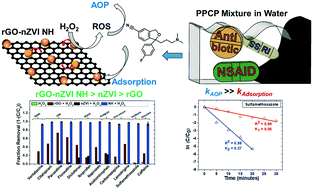Adsorption and advanced oxidation of diverse pharmaceuticals and personal care products (PPCPs) from water using highly efficient rGO–nZVI nanohybrids†
Abstract
Engineered nanomaterials, like graphene with tunable adsorption sites and nanoscale zero-valent iron (nZVI) with unique redox chemistry, offer great prospects for removing pharmaceutical and personal care products (PPCPs) through adsorption and catalytic advanced oxidation processes (AOPs) in comparison to bulk materials. Although PPCPs are found as a complex mixture in wastewater and in the environment, most studies regarding nano-enabled PPCP removal reported results with only one PPCP at a time and typically at high initial concentrations. In this study, we utilized reduced graphene oxide (rGO) as a support for nZVI to synthesize rGO–nZVI nanohybrids (NHs) and used rGO–nZVI NHs for the removal of a complex mixture of 12 diverse PPCPs that includes antibiotic, anti-inflammatory, anti-seizure, and antidepressant pharmaceuticals, which are recalcitrant in the environment. We also tested the removal of PPCPs at their individual environmentally relevant concentrations at the ppb level. The rGO–nZVI NH was synergistically utilized as both an adsorbent and a heterogeneous Fenton catalyst (for AOPs) in the presence of H2O2 to remove ∼95–99% of environmentally relevant concentrations (200 ppb) of PPCPs within 10 minutes. Even in the absence of H2O2, the hybridization resulted in better adsorptive properties (14–72% more removal) of the rGO–nZVI NHs compared to the parent nanomaterials (rGO or nZVI) for various PPCPs in the mixture, removing ∼82–99% of PPCPs, at the end of 30 minutes, with comparatively slower kinetics (∼3–5.5 times) than in the presence of H2O2. Hydrophobic PPCPs were removed faster and more PPCPs were removed by both adsorption and AOPs. The potential of utilizing rGO–nZVI NHs in drinking/wastewater treatment systems, or even in point-of-use systems where necessary, was substantiated by the enhanced and fast PPCP removal capacity of nanohybrids.



 Please wait while we load your content...
Please wait while we load your content...